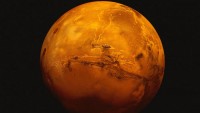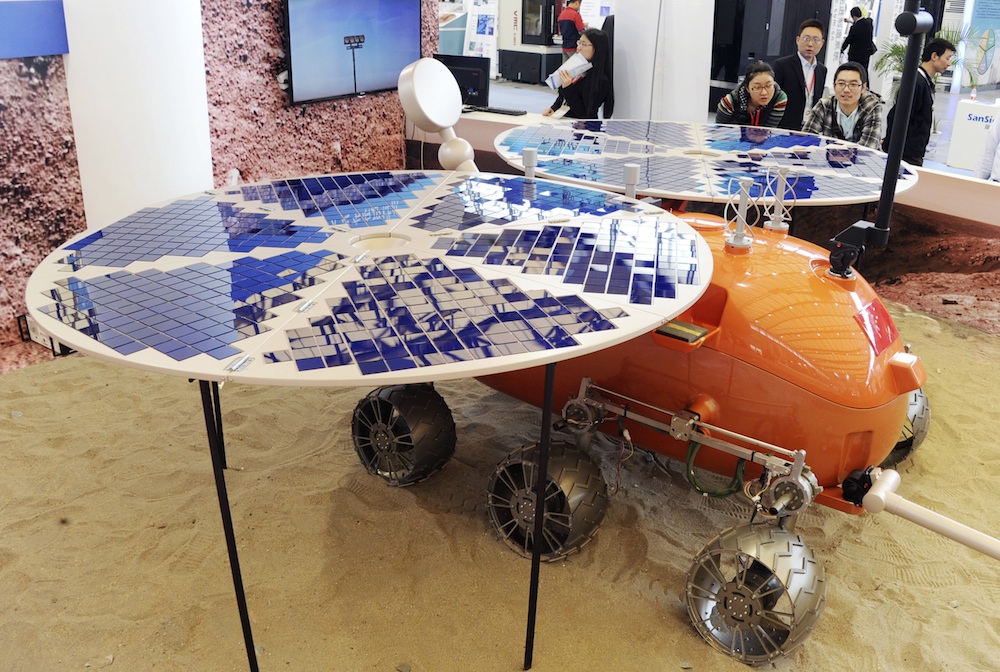NASA Discovers Harvesting Water Possible on Mars
| Michael A. Katz | | Apr 13, 2015 02:27 PM EDT |
(Photo : NASA) The Rover Environmental Monitoring Station (REMS) on NASA's Curiosity Mars rover includes temperature and humidity sensors mounted on the rover's mast.
New data released by NASA shows that astronauts may one day be able to harvest water on Mars, a necessity for humans to be able to colonize the red planet.
"Liquid water is a requirement for life as we know it, and a target for Mars exploration missions," said the report's lead author, Javier Martin-Torres of Lulea University of Technology, Sweden, and a member of Curiosity's science team.
Like Us on Facebook
NASA's Mars Science Laboratory Project is using Curiosity to investigate both ancient and modern environmental conditions in Mars' Gale Crater region.
The findings were based on more than a full Mars year of temperature and humidity measurements by NASA's Curiosity rover team. According to their calculations, conditions at the rover's near-equatorial location were ideal for small amounts of brine to form during some nights, drying out again after dawn. NASA said that this could occur more frequently at higher latitudes, where colder temperatures and more water vapor can result in more humid conditions.
"Conditions near the surface of present-day Mars are hardly favorable for microbial life as we know it, but the possibility for liquid brines on Mars has wider implications for habitability and geological water-related processes."
The weather and soil conditions on Mars, as measured by NASA's Curiosity rover, together with a type of salt found in Martian soil, could saturate the soil with liquid brine at night.
The Curiosity team has previously identified perchlorate in Martian soil, which has properties of absorbing water vapor from the atmosphere while lowering its freezing temperature. NASA says that this has been proposed for years as a mechanism for possible existence of transient liquid brines at higher latitudes on Mars despite itss cold, dry conditions.
The weather data in the report come from the Cuirosity's Rover Environmental Monitoring Station (REMS), which was provided by Spain. The station includes a relative-humidity sensor and a ground-temperature sensor.
"We have not detected brines, but calculating the possibility that they might exist in Gale Crater during some nights testifies to the value of the round-the-clock and year-round measurements REMS is providing," said Curiosity Project scientist Ashwin Vasavada.
Curiosity is the first mission to measure relative humidity in the Martian atmosphere close to the surface, and year-round ground temperature. Relative humidity depends on the temperature of the air, as well as the amount of water vapor in it.
The rover's measurements of relative humidity range from about 5 percent on summer afternoons to 100 percent on fall and winter nights.
TagsNASA Data Shows Harvesting Water Possible on Mars, curiosity, rover, NASA, Rover Environmental Monitoring Station, REMS, Javier Martin-Torres, Lulea University of Technology, Ashwin Vasavada
©2015 Chinatopix All rights reserved. Do not reproduce without permission
EDITOR'S PICKS
-

Did the Trump administration just announce plans for a trade war with ‘hostile’ China and Russia?
-

US Senate passes Taiwan travel bill slammed by China
-

As Yan Sihong’s family grieves, here are other Chinese students who went missing abroad. Some have never been found
-

Beijing blasts Western critics who ‘smear China’ with the term sharp power
-

China Envoy Seeks to Defuse Tensions With U.S. as a Trade War Brews
-

Singapore's Deputy PM Provides Bitcoin Vote of Confidence Amid China's Blanket Bans
-

China warns investors over risks in overseas virtual currency trading
-

Chinese government most trustworthy: survey
-

Kashima Antlers On Course For Back-To-Back Titles
MOST POPULAR
LATEST NEWS
Zhou Yongkang: China's Former Security Chief Sentenced to Life in Prison

China's former Chief of the Ministry of Public Security, Zhou Yongkang, has been given a life sentence after he was found guilty of abusing his office, bribery and deliberately ... Full Article
TRENDING STORY

China Pork Prices Expected to Stabilize As The Supplies Recover

Elephone P9000 Smartphone is now on Sale on Amazon India

There's a Big Chance Cliffhangers Won't Still Be Resolved When Grey's Anatomy Season 13 Returns

Supreme Court Ruled on Samsung vs Apple Dispute for Patent Infringement

Microsoft Surface Pro 5 Rumors and Release Date: What is the Latest?













